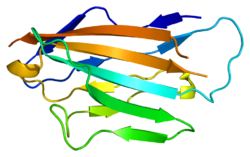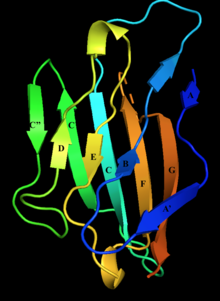Myelin protein zero
| MPZ | |||||||||||||||||||||||||||||||||||||||||||||||||||
|---|---|---|---|---|---|---|---|---|---|---|---|---|---|---|---|---|---|---|---|---|---|---|---|---|---|---|---|---|---|---|---|---|---|---|---|---|---|---|---|---|---|---|---|---|---|---|---|---|---|---|---|
 | |||||||||||||||||||||||||||||||||||||||||||||||||||
| |||||||||||||||||||||||||||||||||||||||||||||||||||
| Identifiers | |||||||||||||||||||||||||||||||||||||||||||||||||||
| Aliases | MPZ,CHM, CMT1, CMT1B, CMT2I, CMT2J, CMT4E, CMTDI3, CMTDID, DSS, HMSNIB, MPP, P0, myelin protein zero, CHN2 | ||||||||||||||||||||||||||||||||||||||||||||||||||
| External IDs | OMIM:159440;MGI:103177;HomoloGene:445;GeneCards:MPZ;OMA:MPZ - orthologs | ||||||||||||||||||||||||||||||||||||||||||||||||||
| |||||||||||||||||||||||||||||||||||||||||||||||||||
| |||||||||||||||||||||||||||||||||||||||||||||||||||
| |||||||||||||||||||||||||||||||||||||||||||||||||||
| |||||||||||||||||||||||||||||||||||||||||||||||||||
| |||||||||||||||||||||||||||||||||||||||||||||||||||
| Wikidata | |||||||||||||||||||||||||||||||||||||||||||||||||||
| |||||||||||||||||||||||||||||||||||||||||||||||||||
Myelin protein zero(P0,MPZ) is a single membraneglycoprotein[5]which in humans is encoded by theMPZgene. P0 is a major structural component of themyelin sheathin theperipheral nervous system (PNS).[6]Myelin protein zero is expressed bySchwann cellsand accounts for over 50% of all proteins in the peripheral nervous system, making it the most common protein expressed in the PNS.[6]Mutations in myelin protein zero can cause myelin deficiency and are associated withneuropathieslikeCharcot–Marie–Tooth diseaseandDejerine–Sottas disease.[7]
Structure
[edit]| Myelin-PO_C | |||||||||
|---|---|---|---|---|---|---|---|---|---|
 Structure of myelin protein zero's extracellular domain with labelled beta strands. Strands D, E, B, and A make up one beta sheet, Strands A', G, F, C, C', C'' make up the other beta sheet. | |||||||||
| Identifiers | |||||||||
| Symbol | Myelin-PO_C | ||||||||
| Pfam | PF10570 | ||||||||
| InterPro | IPR019566 | ||||||||
| OPM superfamily | 193 | ||||||||
| OPM protein | 3oai | ||||||||
| Membranome | 213 | ||||||||
| |||||||||
In humans, the gene that encodes myelin protein zero is located onchromosome 1near theDuffy locusor the Duffy antigen/chemokine receptor. The gene is about 7,000 bases long and is divided into 6 exons. In total, myelin protein zero is 219 amino acids long[6]and has many basic amino acid residues.[8]
Myelin protein zero consists of anextracellularN-terminal domain (amino acids 1–124), a singletransmembraneregion (125–150), and a smaller positively chargedintracellularregion (151–219).[6][9][10]Its cytoplasmic domain is highly positively charged but presumably does not fold into a globular structure.[11]The extracellular domain is structurally similar to theimmunoglobulindomain[8]and therefore the protein is considered as belonging toimmunoglobulin superfamily.[12]
Besides existing as a monomer, myelin protein zero is also known to form dimers and tetramers with other myelin protein zero molecules in vertebrates.[13]
Function
[edit]Themyelin sheathis a multi-layered membrane, unique to the nervous system, that functions as an insulator to greatly increase the velocity of axonal impulse conduction. Myelin protein zero, absent in the central nervous system,[14]is a major component of themyelinsheath inperipheralnerves.Mutations that disrupt the function of myelin protein zero can lead to less expression of myelin and degeneration of myelin sheath in the peripheral nervous system.[15]Currently, myelin protein zero expression is postulated to be produced by signals from the axon. However, more details about the regulation of myelin protein zero are unknown.[6]
It is postulated that myelin protein zero is astructural elementin the formation and stabilization of peripheral nerve myelin.[9]Myelin protein zero is also hypothesized to serve as a cell adhesion molecule, holding multiple layers of myelin together.[10]When a myelinating cell wraps its membrane around an axon multiple times, generating multiple layers of myelin, myelin protein zero helps keep these sheets compact by serving as a "glue" that keeps the layers of myelin together.[11]It does so by holding its characteristic coilstructuretogether by the electrostatic interactions[8]of its positively charged intracellular domain withacidiclipidsin thecytoplasmicface of the opposite bilayer.[14]and by interaction betweenhydrophobicglobular 'heads' of adjacent extracellulardomains.[14]
Myelin protein zero's function is similar to the function of other proteins with immunoglobin domains like polyimmunoglobin and T4 protein. These proteins function as binding and adhesion molecules and participate in homotypic interactions, or interactions that involve two similar proteins.[9]Myelin protein zero holds together the myelin sheath by participating in homotypic interactions with other myelin protein zero proteins. Myelin protein zero's extracellular domain binds to the myelinsphingolipidmembrane and holds together myelin layers using homotypic interactions with other myelin protein zero extracellular domains,[7]and with extracellular tryptophan residues interacting with the membrane.[8]
Myelin protein zero has also been demonstrated tointeractwith other proteins likeperipheral myelin protein 22.[16]However, at this point the purpose of these interactions has not yet been determined.[16]
Associations with neuropathy
[edit]Mutations in myelin protein zero are known to cause myelin degeneration andneuropathy.[7]Mutations that reduce myelin protein zero's adhesion function or its ability to participate in homeotypic interactions with other myelin protein zero proteins are thought to cause neuropathy.[17]Mutations to myelin protein zero can lead to issues with the development of myelin early on in life or myelin degeneration on the axon later on in life.[12]Some mutations can cause neuropathy in infancy likeDerjerine-Sottas diseasewhile other mutations can cause neuropathy within the first two decades of life likeCharcot-Marie-Tooth disease.[7]Adding a charged amino acid or changing a cysteine residue in the extracellular membrane can lead to neuropathy onset early on. Truncating the cytoplasmic domain or changing the tertiary structure of myelin protein zero can also result in neuropathy[7]because the cytoplasmic domain has been demonstrated to be necessary for homotypic interactions.[12]
References
[edit]- ^abcGRCh38: Ensembl release 89: ENSG00000158887–Ensembl,May 2017
- ^abcGRCm38: Ensembl release 89: ENSMUSG00000056569–Ensembl,May 2017
- ^"Human PubMed Reference:".National Center for Biotechnology Information, U.S. National Library of Medicine.
- ^"Mouse PubMed Reference:".National Center for Biotechnology Information, U.S. National Library of Medicine.
- ^Magnaghi V, Cavarretta I, Galbiati M, Martini L, Melcangi RC (November 2001). "Neuroactive steroids and peripheral myelin proteins".Brain Research. Brain Research Reviews.37(1–3): 360–71.doi:10.1016/s0165-0173(01)00140-0.PMID11744100.S2CID8004545.
- ^abcdeShy ME (March 2006). "Peripheral neuropathies caused by mutations in the myelin protein zero".Journal of the Neurological Sciences.242(1–2): 55–66.doi:10.1016/j.jns.2005.11.015.PMID16414078.S2CID32802793.
- ^abcdeShy ME, Jáni A, Krajewski K, Grandis M, Lewis RA, Li J, et al. (February 2004)."Phenotypic clustering in MPZ mutations".Brain.127(Pt 2): 371–84.doi:10.1093/brain/awh048.PMID14711881.
- ^abcdShapiro L, Doyle JP, Hensley P, Colman DR, Hendrickson WA (September 1996)."Crystal structure of the extracellular domain from P0, the major structural protein of peripheral nerve myelin".Neuron.17(3): 435–49.doi:10.1016/s0896-6273(00)80176-2.PMID8816707.S2CID1719833.
- ^abcLemke G, Axel R (March 1985). "Isolation and sequence of a cDNA encoding the major structural protein of peripheral myelin".Cell.40(3): 501–8.doi:10.1016/0092-8674(85)90198-9.PMID2578885.S2CID1230708.
- ^abLemke G, Lamar E, Patterson J (March 1988). "Isolation and analysis of the gene encoding peripheral myelin protein zero".Neuron.1(1): 73–83.doi:10.1016/0896-6273(88)90211-5.PMID2483091.S2CID51695021.
- ^abHan H, Myllykoski M, Ruskamo S, Wang C, Kursula P (January 2013). "Myelin-specific proteins: a structurally diverse group of membrane-interacting molecules".BioFactors.39(3): 233–41.doi:10.1002/biof.1076.PMID23780694.S2CID21111930.
- ^abcKamholz JA, Brucal M, Li J, Shy M (2007), "Myelin Protein Zero and CMT1B: A Tale of Two Phenotypes",Molecular Neurology,Elsevier, pp. 463–474,doi:10.1016/b978-012369509-3.50031-7,ISBN9780123695093
- ^Thompson AJ, Cronin MS, Kirschner DA (March 2002). "Myelin protein zero exists as dimers and tetramers in native membranes of Xenopus laevis peripheral nerve".Journal of Neuroscience Research.67(6): 766–71.doi:10.1002/jnr.10167.PMID11891790.S2CID36556147.
- ^abcSakamoto Y, Kitamura K, Yoshimura K, Nishijima T, Uyemura K (March 1987)."Complete amino acid sequence of PO protein in bovine peripheral nerve myelin".The Journal of Biological Chemistry.262(9): 4208–14.doi:10.1016/S0021-9258(18)61334-1.PMID2435734.
- ^Kirschner DA, Inouye H, Saavedra RA (November 1996)."Membrane adhesion in peripheral myelin: good and bad wraps with protein P0".Structure.4(11): 1239–44.doi:10.1016/s0969-2126(96)00132-3.PMID8939762.
- ^abD'Urso D, Ehrhardt P, Müller HW (May 1999)."Peripheral myelin protein 22 and protein zero: a novel association in peripheral nervous system myelin".The Journal of Neuroscience.19(9): 3396–403.doi:10.1523/JNEUROSCI.19-09-03396.1999.PMC6782240.PMID10212299.
- ^Pareyson D, Marchesi C, Salsano E (2013), "Dominant Charcot–Marie–Tooth syndrome and cognate disorders",Peripheral Nerve Disorders,Handbook of Clinical Neurology, vol. 115, Elsevier, pp. 817–845,doi:10.1016/b978-0-444-52902-2.00047-3,ISBN9780444529022,PMID23931817
Further reading
[edit]- Patel PI, Lupski JR (April 1994). "Charcot-Marie-Tooth disease: a new paradigm for the mechanism of inherited disease".Trends in Genetics.10(4): 128–33.doi:10.1016/0168-9525(94)90214-3.PMID7518101.
- Roa BB, Lupski JR (1994). "Molecular Genetics of Charcot-Marie-Tooth Neuropathy".Advances in Human Genetics.Vol. 22. pp. 117–52.doi:10.1007/978-1-4757-9062-7_3.ISBN978-1-4757-9064-1.PMID7762451.
- Nelis E, Haites N, Van Broeckhoven C (1999)."Mutations in the peripheral myelin genes and associated genes in inherited peripheral neuropathies".Human Mutation.13(1): 11–28.doi:10.1002/(SICI)1098-1004(1999)13:1<11::AID-HUMU2>3.0.CO;2-A.PMID9888385.S2CID31130790.
- Watanabe M, Yamamoto N, Ohkoshi N, Nagata H, Kohno Y, Hayashi A, et al. (September 2002). "Corticosteroid- responsive asymmetric neuropathy with a myelin protein zero gene mutation".Neurology.59(5): 767–9.doi:10.1212/wnl.59.5.767.PMID12221176.
- Hattori N, Yamamoto M, Yoshihara T, Koike H, Nakagawa M, Yoshikawa H, et al. (January 2003)."Demyelinating and axonal features of Charcot-Marie-Tooth disease with mutations of myelin-related proteins (PMP22, MPZ and Cx32): a clinicopathological study of 205 Japanese patients".Brain.126(Pt 1): 134–51.doi:10.1093/brain/awg012.PMID12477701.
- Shy ME (March 2006). "Peripheral neuropathies caused by mutations in the myelin protein zero".Journal of the Neurological Sciences.242(1–2): 55–66.doi:10.1016/j.jns.2005.11.015.PMID16414078.S2CID32802793.
- Hayasaka K, Nanao K, Tahara M, Sato W, Takada G, Miura M, et al. (October 1991). "Isolation and sequence determination of cDNA encoding the major structural protein of human peripheral myelin".Biochemical and Biophysical Research Communications.180(2): 515–8.doi:10.1016/S0006-291X(05)81094-0.PMID1719967.
- Ouvrier RA, McLeod JG, Conchin TE (February 1987). "The hypertrophic forms of hereditary motor and sensory neuropathy. A study of hypertrophic Charcot-Marie-Tooth disease (HMSN type I) and Dejerine-Sottas disease (HMSN type III) in childhood".Brain.110 ( Pt 1) (1): 121–48.doi:10.1093/brain/110.1.121.PMID3467805.
- Tachi N, Ishikawa Y, Minami R (1985). "Two cases of congenital hypomyelination neuropathy".Brain & Development.6(6): 560–5.doi:10.1016/s0387-7604(84)80101-1.PMID6099985.S2CID4767216.
- Hayasaka K, Himoro M, Wang Y, Takata M, Minoshima S, Shimizu N, et al. (September 1993). "Structure and chromosomal localization of the gene encoding the human myelin protein zero (MPZ)".Genomics.17(3): 755–8.doi:10.1006/geno.1993.1400.PMID7503936.
- Su Y, Brooks DG, Li L, Lepercq J, Trofatter JA, Ravetch JV, et al. (November 1993)."Myelin protein zero gene mutated in Charcot-Marie-tooth type 1B patients".Proceedings of the National Academy of Sciences of the United States of America.90(22): 10856–60.Bibcode:1993PNAS...9010856S.doi:10.1073/pnas.90.22.10856.PMC47877.PMID7504284.
- Himoro M, Yoshikawa H, Matsui T, Mitsui Y, Takahashi M, Kaido M, et al. (September 1993). "New mutation of the myelin P0 gene in a pedigree of Charcot-Marie-Tooth neuropathy 1".Biochemistry and Molecular Biology International.31(1): 169–73.PMID7505151.
- Hayasaka K, Himoro M, Sawaishi Y, Nanao K, Takahashi T, Takada G, et al. (November 1993). "De novo mutation of the myelin P0 gene in Dejerine-Sottas disease (hereditary motor and sensory neuropathy type III)".Nature Genetics.5(3): 266–8.doi:10.1038/ng1193-266.PMID7506095.S2CID2512684.
- Pham-Dinh D, Fourbil Y, Blanquet F, Mattéi MG, Roeckel N, Latour P, et al. (December 1993). "The major peripheral myelin protein zero gene: structure and localization in the cluster of Fc gamma receptor genes on human chromosome 1q21.3-q23".Human Molecular Genetics.2(12): 2051–4.doi:10.1093/hmg/2.12.2051.PMID7509228.
- Thomas FP, Lebo RV, Rosoklija G, Ding XS, Lovelace RE, Latov N, et al. (1994). "Tomaculous neuropathy in chromosome 1 Charcot-Marie-Tooth syndrome".Acta Neuropathologica.87(1): 91–7.doi:10.1007/BF00386259.PMID7511317.S2CID19827120.
- Nelis E, Timmerman V, De Jonghe P, Vandenberghe A, Pham-Dinh D, Dautigny A, et al. (December 1994). "Rapid screening of myelin genes in CMT1 patients by SSCP analysis: identification of new mutations and polymorphisms in the P0 gene".Human Genetics.94(6): 653–7.doi:10.1007/bf00206959.PMID7527371.S2CID5750189.
- Hilmi S, Fournier M, Valeins H, Gandar JC, Bonnet J (February 1995). "Myelin P0 glycoprotein: identification of the site phosphorylated in vitro and in vivo by endogenous protein kinases".Journal of Neurochemistry.64(2): 902–7.doi:10.1046/j.1471-4159.1995.64020902.x.PMID7530295.S2CID32511382.
- Rautenstrauss B, Nelis E, Grehl H, Pfeiffer RA, Van Broeckhoven C (September 1994). "Identification of a de novo insertional mutation in P0 in a patient with a Déjérine-Sottas syndrome (DSS) phenotype".Human Molecular Genetics.3(9): 1701–2.doi:10.1093/hmg/3.9.1701.PMID7530550.
- Latour P, Blanquet F, Nelis E, Bonnebouche C, Chapon F, Diraison P, et al. (1995)."Mutations in the myelin protein zero gene associated with Charcot-Marie-Tooth disease type 1B".Human Mutation.6(1): 50–4.doi:10.1002/humu.1380060110.PMID7550231.S2CID20852048.
External links
[edit]- GeneReviews/NCBI/NIH/UW entry on Charcot-Marie-Tooth Neuropathy Type 1
- GeneReviews/NCBI/NIH/UW entry on Charcot-Marie-Tooth Neuropathy Type 2
- Myelin+protein+zeroat the U.S. National Library of MedicineMedical Subject Headings(MeSH)
- Overview of all the structural information available in thePDBforUniProt:P25189(Myelin protein P0) at thePDBe-KB.






